If you’re reading this and don’t know me personally, you’re probably aware that Crashplan decided to “sunset” their Crashplan Home offering on August 22nd last year. No new subscriptions are being taken, and it will cease to exist from August 2018. Unfortunately, my subscription expired in December.
I was hugely satisfied with Crashplan, and thought it was by far the best online cloud backup solution in the market for the average home user.
- It offered free peer-to-peer backups which meant I could backup my devices to my own server, or even trade encrypted backups with friends.
- The client to backup to your own devices was free, and the cost for online cloud backups was a very-reasonable $150 USD for 12-months of unlimited backup storage.
- By virtue of being written in Java, the client was available for Windows, Mac and Linux (I have all 3).
- It supported headless operation, albeit with a bit of jiggery-pokery, i.e. editing the client config file to point to another agent via an SSH tunnel. This meant I could run it on my home NAS device, which naturally stores my important data (Photos mainly).
- No limits on the number of devices that were backed up, or charges per-device.
Naturally, I was disappointed when they announced they were discontinuing it. “No worries!” I thought, there must be something else out there. As it turns out, Crashplan Home was almost too good to be true.
This post is similar to others I’ve read, in that it details my research of alternatives to Crashplan and why I settled on what I did and why (spoiler: I have gone the DIY route).
My requirements are fairly straightforward:
- 1-2TB of data
- Set-and-forget automatic backups, so I don’t have to think about it
- Windows, Mac and Linux support
- Zero-knowledge encryption, no other entity must be able to reach my data unencrypted
- Local backups to my NAS, as well as remote backups to the cloud
The Commercial Contenders
Crashplan for Small Business
Oh where to begin.
Crashplan for Small Business, henceforth referred to as CPfSB, or Crashplan for Scatter-Brains, was the first option I considered, because naturally I wanted to maintain the status quo as much as possible.
The charging moves to per-device, but they also offered it to ex-Home customers at a 75% discount for 12 months, which works out at $2.50 per device, so I figured I had nothing to lose by migrating for a year at least, after which I could just carry on with my two most important devices (my laptop and NAS), and just do local backups from the others to the NAS via some other method.
Ironically, this meant that even after the 12-month discount I would be paying Crashplan less than half the amount per year than I was paying them for Home! But I soon dropped it like a stone when I realised how much they’d castrated it compared to the Home offering.
I’ll start with the removal of peer-to-peer backups. This was, for me, a key feature of the old CrashPlan, and it made secure, reliable backups a snap. I installed the Crashplan on my computers (3 of them), and my NAS, configuring them all to back up to both my local NAS server and Crashplan online. I also created an account for my girlfriend, then linked her account to mine so she could back up to the NAS as well. That way, if either of us lost a device, all the important data was safely stored on the NAS. If we lost everything, we could recover from Crashplan’s cloud. In essence, it was a two-tier backup solution in one, and I was a happy customer.
I could live with having to create a new local backup solution and only using Crashplan for cloud. But if the removal of P2P backups irritated me, the fuckery over headless servers pushed me over the edge.
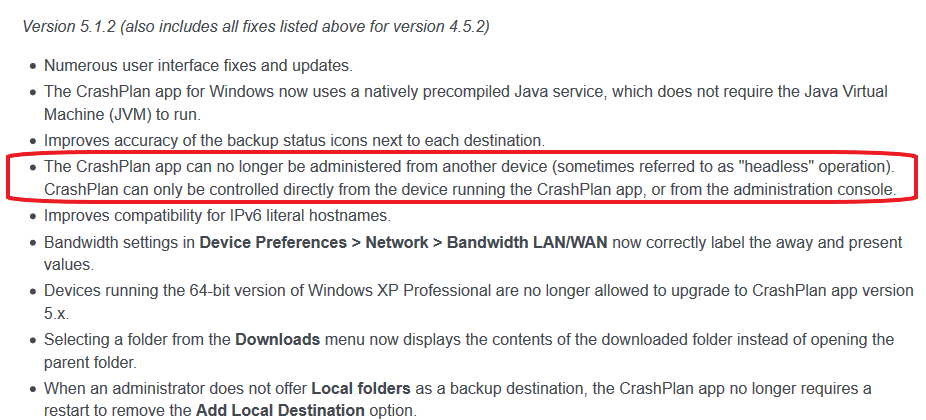
The Crashplan 5.1 release notes – the only evidence I can find of users being notified about the change in policy on remote administration.
Apparently, headless server configurations are “no-longer supported”. It would have been nice to have been informed of this before I migrated. The only evidence I can find that customers were even notified of this change, is in the release notes for a version which I was not able to use at the time, as Crashplan for Home was never allowed past version 4.
OK, fine, it’s not “supported”. But I can still work around it right? It’s not like the previous “support” was anything more than a hack!
After migrating to CPfSB, my laptop continued backup up, but the NAS backups stopped cold. The server showed as online in the panel, but no backups were being performed. Strangely, the backup report emails were putting a big green tick next to my nas, giving the impression all was well! This couldn’t be further from the truth.
I’m going to get a bit technical here, but it’s important to note the client/server architecture is the same asCrashplan 4 (the last Home version) through to 6.6 (the current Small Business version). There is still a background Java daemon which performs the backups, and a front-end client, which connects to the server to configure it. So there’s no reason, if you provide a path for a client on another machine to connect to the server, that it couldn’t work with it, unless it was designed not to.
I tried the previous Crashplan 4 method, which naturally didn’t work. After discovering that the ports had changed and there was a port serving up http, I tried a number of URLs and pointing the client at it, even forwarding the local port to the nas, but to no avail. It wouldn’t connect. No real surprise there.
Then I had an idea. If I could start the server’s client with ssh -X, running it under X and forwarding the display to my Mac while still running the client on the NAS it would have to work, right? In this case I was presented with the client’s login screen, but it wouldn’t accept my username and password. The server logs, in /usr/local/crashplan/log, are actually quite verbose:
[12.15.17 22:35:19.819 INFO ystemWatcher 42.service.peer.ReauthorizeCheck] REAUTH_CHECK:: REAUTH with a non-default interval, reauthorizeInterval=900000 [12.15.17 22:35:19.819 INFO ystemWatcher backup42.service.peer.Authorizer] AUTH:: REAUTH - username=**** [12.15.17 22:35:19.819 INFO ystemWatcher backup42.service.peer.Authorizer] AUTH:: REAUTH, username=****, passwordExists=false, requestMessage=null, register=false, firstName=null, lastName=null, registrationKey=null, waitTimeMillis=120000 [12.15.17 22:35:19.819 INFO ystemWatcher ssaging.network.nio.MessageQueue] MW:: STATS:Peer : numWorkers=4, queue.size=0, MessageQueueStats[num=0, numSinceLast=0, handling=Counter[count = 0, rate = 0.00, rollingRate = 0.00], waiting=Counter[count = 0, rate = 0.00, rollingRate = 0.00], workload=1.000] [12.15.17 22:35:19.819 INFO 6446_AUTH-14 backup42.service.peer.Authorizer] AUTH:: *** START *** with Authorizer@826692977[ REAUTH, username=****] [12.15.17 22:35:19.833 INFO 6446_AUTH-14 backup42.service.peer.Authorizer] AUTH:: Authority address: central.crashplan.com/216.17.8.7 [12.15.17 22:35:19.833 INFO 6446_AUTH-14 backup42.service.peer.Authorizer] AUTH:: Beginning authorization with Authorizer@826692977[ REAUTH, username=****] [12.15.17 22:35:19.845 INFO 6446_AUTH-14 backup42.service.peer.Authorizer] AUTH:: CPCLoginMessage@1903567243[ guid=670321348152656129, productVersion=6.6.0, authDate=1420290846938, username=****, loginKey=****, orgType=CONSUMER, computerType=COMPUTER, address= 192.168.10.3:4242, computerName = nas, dataKeyChecksum = 8a36b3d4254edd31957d7a7efb08eed4, configDate=1503386178763, socialNetworkDate=1513365351184, challengeResponse=false, externalAuthenticatorSessionId=null, securityKeyType=PrivatePassword, duplicateGuidDetectionCounter=14 ] [12.15.17 22:35:20.031 INFO 6446_AUTH-14 backup42.service.peer.Authorizer] AUTH:: CPCLoginResponseMessage@-2113284415[remoteId=136962048763636368, session=826475928340194318, remoteGuid=4200, errors=Login.FAILED] [12.15.17 22:35:20.031 INFO 6446_AUTH-14 backup42.service.peer.Authorizer] AUTH:: Error = CPErrors.Login.FAILED : [] [12.15.17 22:35:20.031 INFO 6446_AUTH-14 backup42.service.peer.Authorizer] AUTH:: *** END *** Failed after 212ms
Here we can see the server attempting to login to the Crashplan Cloud server, and receiving a “CPCLoginResponseMessage” containing “errors=Login.FAILED”. This didn’t happen with my laptop, but was appearing on the Nas whenever I attempted to login to the UI. And the credentials were definitely correct – I confirmed them by logging in via the web.
Next stop was the new fancy Small Business web UI, perhaps I could kick it from there. It seems the intention is to allow you to completely administrate from the web and not need a local UI, which is a great idea, but somehow they managed to make the user experience worse than the already-quite-poor Java client.
I was able to login, restart the daemon, and restore files. Everything but start a backup. It shows me a nice big green tick, and does nothing. It seems the Crashplan client on my NAS was broken.
If by some miracle I was happy to continue using Crashplan at this point, it would have been time to contact support, but I realised I was wrestling with a product from a company that didn’t really want me as a customer anyway, so I decided CPfSB wasn’t for me and cancelled my subscription, giving me one month to find an alternative.
Carbonite
Crashplan recommended their “exclusive partner” Carbonite, which is a very reasonable $60 per year. For one device.
For multiple devices, the cost starts at $270/yr. In all fairness, the number of devices is unlimited, but doesn’t include servers. If that wasn’t enough, there is no Linux client, which meant that even paying the $600 per year for server support, it would still be useless to me.
If the software is good (I haven’t tried it), and you don’t need Linux support, it could be worth trying out if you don’t mind the cost. I passed.
Backblaze
$50 per year per computer for unlimited storage is fairly reasonable if you have one or two devices. But it doesn’t support Linux. So for me, it’s a pass.
Backblaze B2
But wait! Backblaze does have an S3-like cloud storage API. This is a DIY solution though.
As it’s not really an off-the-shelf solution, I’ll shelve this for now, but their Top Questions from CrashPlan Users article is worth a read.
Mozy
If you thought Carbonite was expensive, prepare to re-mortgage your house. Or give up smoking / drinking / some other form of regular fun.
That the largest published plan for home users is 125GB and you have to “request pricing” for anything over 500GB says it all.
Honestly I am at a loss to explain how they are still in business. Must be a Dell thing.
Spideroak
The main problem with Spideroak One when I researched (around September) was cost. At that time the price for 1TB was $129/yr. That’s now 2TB for the same cost, and there’s a 5TB option for $279/yr which is worth considering if you don’t need more than this and value its features. For me though, it feels like more of a Dropbox competitor more than Crashplan, i.e. it’s designed for active sets of data and sync between devices as opposed to backups.
They do encrypt your data end-to-end though, so you have 0.5-5TB to store and like the client, it’s a reasonable option since the capacity of their plans increased.
Dropbox
I think that you should never use Dropbox for anything remotely private or sensitive. They store your data unencrypted on Amazon S3 (or at least, encrypted with a key they control), and have had security breaches in the past. That said, security standards have certainly risen (they supports two-factor auth) and they employ Guido van Rossum, so they can’t be all bad…
But nothing can make up for the fundamental problem of trusting a third party with your unencrypted data.
Google Drive
It’s Google. All the negatives of Dropbox apply, magnified exponentially by the rest of the data Google has on you.
Just Say No.
OneDrive
Now you’re just trolling.
Going it Alone
As alluded to in the intro, I went with none of the commercial options, and did-it-myself.
As you’re really building your own solution out of discrete components which meet more specific needs, there is no “all-in-one” DIY solution. I need three things to cover what Crashplan Home did for me:
- Local backup software, from device to my NAS
- Cloud backup software, from my NAS to the cloud
- Cloud backup storage
Local Backups
Currently I am using UrBackup. I’m not particularly satisfied with it, as the client software is lacking in some ways. I’m starting to think that a sync-based solution (maybe Syncthing?) to the NAS, and backing up the sync’d data to the cloud separately might be a better solution.
The main problem with UrBackup is that it isn’t as configurable as Crashplan was for scheduling – it’s purely time-based. You can’t configure it to run when the computer is idle for example, or prevent it from running while on battery. It’s a strictly “full + incremental” solution and can’t watch folders or add files to an archive as they are updated.
The UI is also very “utilitarian”. It also supports image backups, which is nice, presumably via BTRFS / Volume Shadow Copy snapshots.
Also the tray icon has four not-particularly-useful states (that I’ve seen so far); Red when running a full backup, Orange when paused, Yellow when running an incremental backup and White when idle. Although it was also Yellow when running a full image backup so now I’m not really sure what the colours mean. I should probably read the source code.
It would be more useful if tray icon changes were reserved for indicating errors or if the backup hadn’t run for some time, but from what I’ve observed thus far it doesn’t do this.
Cloud Backups
Duplicati pops up commonly around the web. I settled on it because it’s designed to be run as a server. It’s administered via a web interface and is highly configurable, supporting many destination types.
To be honest, I’m quite blown away by how good it is. And it’s open source. If you have a NAS server to back up, it should be one of the first you look at.
Other Options
I also tried out Cloudberry and Arq Backup. Both are better thought of as desktop clients than server/NAS solutions, but both appear to be solid options for desktop use.
Between the two, Arq is the simpler UI, it’s very “lightweight”:
CloudBerry on the other hand is busy. Like its website, it looks it could have predated Y2K:
Actually that’s unfair. Despite its love of wizards, CloudBerry is a well thought-out and complete backup tool, and it offers a bewildering number of options. There’s also a free version, which, while not useful for daily use (it restricts the backup options and doesn’t allow encryption), does allow you to try it out and get a feel for its abilities before you buy.
Neither has a web GUI, so Duplicati is naturally a better fit for me on the server side, but they should work well for backing up desktops to a NAS, or directly to the cloud.
Cloud Storage
This is the easy one really. List the companies you trust to keep your data alive and pick the cheapest. Cloud storage is a commodity and you should treat it as such.
I went with Amazon S3 Infrequent access originally, because it was the devil I knew, but am in the process of migrating to Backblaze for cost reasons.
First impression is that it’s slow here from the UK, I’m getting 190KB/sec. It’s going to take a very long time to do the initial backup if that speed proves close to the average, but Crashplan was no speed demon either.
Amazon’s EU endpoints are much, much faster, but I’d rather give Backblaze my money than Jeff Bezos, so I’m going to see how it goes.
Summary
Essentially, I have UrBackup on my devices, sending backups to the NAS, and Duplicati on the NAS backing up to Amazon S3. I’m backing up around 700GB of data, and the Amazon bill is ~$11 per month. This isn’t brilliant value for money, but as long as I’m under $12.50, I’m still spending less than I did on CrashPlan, albeit without the luxury of unlimited storage.
Backblaze should reduce the cost significantly.
Overall, I preferred the ease of use that CrashPlan Home provided, but I’m happy that my backups are now no longer dependent on one company. Cloud providers such as Amazon and Backblaze have more diversified business plans, and are much more likely to stay around. If one of them raises prices or does something I don’t like, I can simply switch provider instead of redesigning my entire backup solution.
A Crashplan Obituary
I don’t know what happened at Code42.
It feels as though they had a problem with profitability which was badly managed.
Without doubt, there are people out there (just take a look at /r/datahoarder) who will truly take advantage of unlimited backup storage; storing terabytes of media which they could probably re-download online anyway. I’m sure there are many videographers and professional photographers that took them up on the offer as well.
In this case, the solution really should have been to charge people more for using more data, and not rely on 99% of users supporting the data-hoarding 1%. But maybe the numbers were worse than that. Despite the fact that “sync is not backup”, perhaps there simply aren’t enough low-volume consumers of online backup software to subsidise the data hoarders.
I still feel there must have been solutions to the profitability problem which wouldn’t have meant killing a perfectly good product, particularly as one of the best features (peer to peer backup) was free, and didn’t cost CrashPlan anything to run, as the storage was provided by customers.
Given the decision to exit, I can only conclude that whoever was responsible for the original Crashplan product left Code42 some time ago, and that the writing has been on the wall for some time.
Perhaps the focus on Small Business and Enterprise will work well for them, but my impression as an ex-Home customer is that the product hasn’t improved since I first signed up more than 4 years ago. The Java client is the same but with less features, the web UI is poor, and the original hacker-friendly ethos that supported headless mode and NAS devices seems to have evaporated.
In its place we have a shitty (but not quite Connected Backup shitty) enterprise wannabe, and I’m glad to see the back of it.

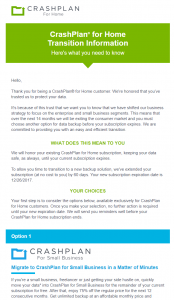
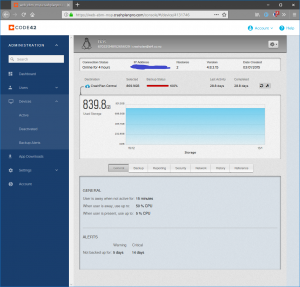
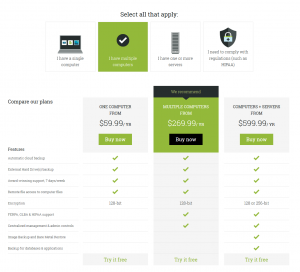

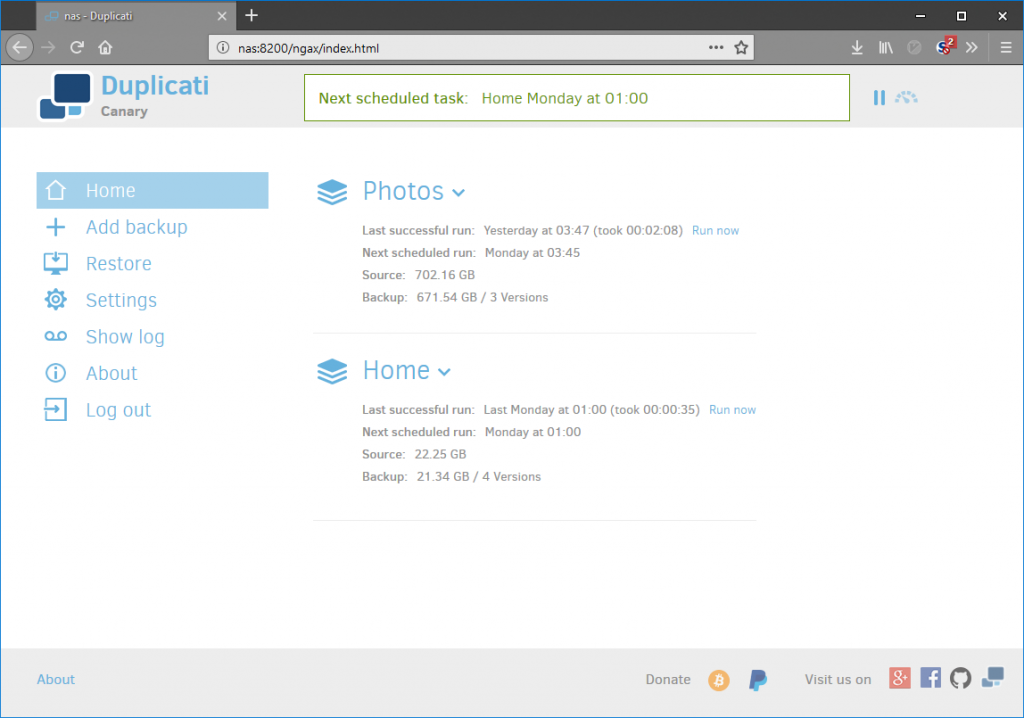


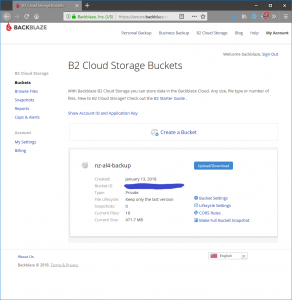
Thank you very much for the excellent analysis and summary… I am going through the same process as my subscription expires in like 2-3 weeks. I am also dissapointed about losing the peer to peer feature, which was really nice to have to backup devices to my Synology NAS.
After some research, my best looking option seems to be iDrive, as it also has an app for Synology.
Hi Antonio, sorry for the slow approval there. Haven’t heard of iDrive, hopefully it works out for you!
Hi Alex, no prob… I have discarded iDrive after reading terrifying customer reviews at this site: https://www.trustpilot.com/review/www.idrive.com between bad performance, getting charged in your credit card even if you have cancelled your account, or customers that have been paying for 5 years, getting their account (and backups) deleted.
thanks for the post – As my WHS is failing I am looking at UrBackup to backup severeal Win10 clients to a Linux server on the same network.
May I ask you some questions?
Are you still using UrBackup? Have you sucessfuly done a restore of a Win10 client?
Hi Paul,
Technically I still intend to use it…. but the server side broke when I upgraded from Ubuntu 16.04 to 18.04 and I haven’t gotten around to fixing it yet. As far as restore goes, I haven’t used it to restore a client and to be honest I’m not sure I would. The main thing for me is be being able to recover things I forgot to backup or save in an appropriate place.
Overall, I’m not particularly satisfied with it, and would prefer something more “Crashplan-like” in approach. I regard OS configuration as ephemeral, in that I’d rather reproduce it from scripts or source than save the state, if that makes sense. The important thing for me is the data.
Pingback: Backups – au revoir Urbackup, bon jour syncthing! | Al4
My setup:
* Ubuntu 16.04 server headless with samba
* Crashplan for small business installed on server, backing up to cloud and local drive
* For each Win10 client use Windows 10 File History to backup to each users samba area on the server. I don’t have any Linux clients.
To configure CrashPlan on a Virtualbox Ubuntu client in Win10:
* ssh -X server xterm
** Run “/usr/local/crashplan/bin/CrashPlanDesktop” in xterm